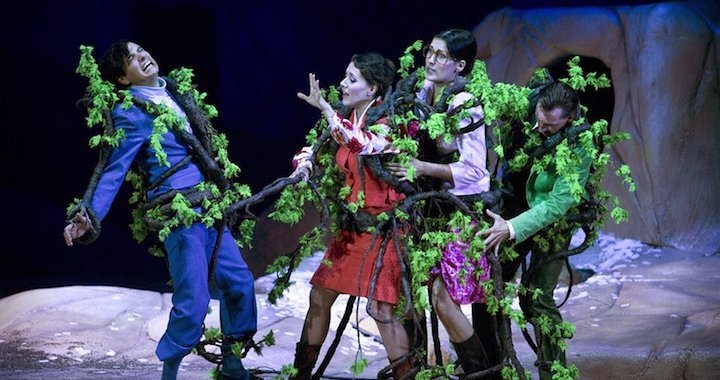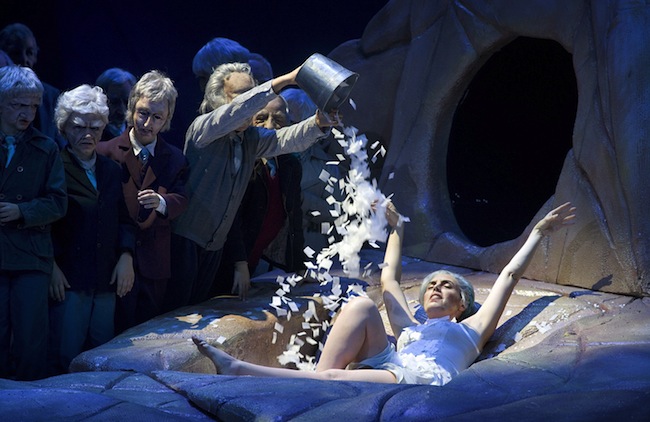
Benjamin Britten as Benjamin Button
On Viesturs Kairišs' production of “A Midsummer Night's Dream”, at the Comic Opera Berlin
Margarita Zieda
03/10/2013
“A Midsummer Night's Dream” at Comic Opera Berlin (Komische Ope Berlin), October 4., 10., 26, 2013; July 8, 2014
American writer Francis Scott Fitzgerald's “The Curious Case of Benjamin Button” has, thanks to David Fincher's film rendition with Brad Pitt in the titular role, given food for thought to a greater number of people than just those who happen to read the classics. Namely, it portrays the progression of a person's life in a different way than we are use to seeing. Instead of developing from an infant to an old man, in the reality of Fitzgerald's world, a person is born old and, over the span of his life, develops into a newborn.
In opening a new viewpoint from which to look upon things and phenomena in a different way than we are used to, artists encourage us to think about the nature of the phenomena. Into what does a person develop? Ever deeper into his or her nature? Or, rather – increasingly further and further away from it? The infant and the old man are the beginning and end of the cycle of human development. Which direction leads to the gaining of experience, and which leads to the erasing of such experience? And what is life itself, this part of the road between birth and death?
In honor of the one-hundredth year since the birth of British composer Benjamin Britten, a team of Latvian and Estonian artists – conductor Kristīne Poska, director Viesturs Kairišs, and scenographer and costume designer Ieva Jurjāne – pose these questions with new artistic vigor by taking a look at the territory of love through their production of the opera “A Midsummer Night's Dream”, at the Comic Opera Berlin (Komische Oper Berlin). It's a territory in which, at least in this show, time has twisted into completely different zones than we are used to in our average daily lives. And “A Midsummer Night's Dream” is no average day. In Britten's musical version of Shakespeare's play by the same name, the astronomical summer solstice, like love, is a moment during which people open themselves up to mysterious experience.

The children's choir of the Comic Opera House and Nicole Chevalier as Titania. Photo: Iko Freese, drama-berlin.de
The opera begins with a powerful picture immersed in the world of surreal music and wonderful voices – an Indian infant lies on the ground, just recently born and illuminated by the cold light of the Universe. And the opera ends with two skeletons, lying side by side in their graves. In Kairišs' production, the amazing voice/elf choir created by Britten is made up of children with the faces of the elderly. And in this span of a human life – or rather, in the span of forever – unfurls a story of love. About a dream during one midsummer's night, from which the people on stage awake already very old, finding themselves in a cold and snowy landscape. The seasons change during the performance – summer is replaced by snow, lovers awake as old men and women, only to later become children again.
Three worlds meet in “A Midsummer Night's Dream”. The invisible world, which at the summer solstice becomes not only palpable, but also visible; you can call this the cosmic powers that be, the elf kingdom, or nature. The lovers' world, which is made up of real people, even though they really don't count anymore because they're in love. And then there's the world inhabited by people who have been blessed with pragmatism; it is represented by artisans who are looking for a place where they can rehearse their play about love without interruption. Therefore, a place where no one will bother them in thinking about how they will portray this love. Don't ask why this place is the forest at night – which is where they try to go and rehearse after work. All three of these worlds collide in the powerful experience that is midsummer's eve, which is impossible to ignore, control or direct – even in its most grotesque form of expression. The source of this love – a magical flower – is in the hands of the elf Puck, as portrayed by Gundars Āboliņš. When the juice from the “bleeding heart” flower gets into the eyes of a person, he falls in love with the first person he sees. What we are shown is the blindness of love, and its limited life-span; Shakespeare chose these real-life phenomena as the driving engine and theme for this comedy in which he peopled a magic forest with beings from such disparate worlds. The setting of Britten's opera is also a forest, which has an “indeterminable fairytale atmosphere”.
Scenographer Ieva Jurjāne's stage for “A Midsummer Night's Dream” is something quite the opposite of an overgrown forest – it is a scene of the naked cliffs of the skin of a very old person, with all of its hillocks and valleys. A landscape of completely stripped-down souls, with no place to hide. Clearly open to view, and concurrently, open to magical images.
The ambivalence of human gender opens up in the mystery of love that is William Shakespeare's “A Midsummer Night's Dream”, and in Benjamin Britten's version – even more so. Britten's King of the Elves – Oberon, is written for a gender-ambiguous contra-tenor, even though according to all operatic conventions, Oberon should have been a bass. But in the summer solstice created by Kairišs and Jurjāne, it is the ambiguity of age that is brought to the forefront. And this is also where the originality of the production lies – instead of projecting the phenomenon of love onto the cliché-limited age group of 12 to 40, it is looked upon in the scope of a whole human life-span, allowing for love to travel through a person from infancy to old age, and then catapulting back into puberty. And in opening up the elf-world, they have created it completely differently than other artists from around the world have perceived it and re-created it up to now. Instead of colorful butterflies, flashing glowworms and happy children, the elf world of Kairišs and Jurjāne is inhabited by elderly faces that sing with the voices of children. It is something age-old that continues to live in the clarity and cleanness of a child's voice. Like in Gundars Āboliņš's Puck, the messenger of love – a graying oddball running around in children's clothing in which the child and the mature adult combine in an artistic lightness.
Not so successful are the production's attempts at adding Freudian explanations – something which causes few to discover new insights these days – to the already original viewpoint that the authors have developed. The total cramming of the stage with teddy bears of various sizes at the beginning of the performance, and the more than 20 minutes that are spent on messing around with them, has become a stumbling stone for many German critics. Having been angrily delayed by it, they did not want to go on to follow Kairišs and Jurjāne in their new take on, and new experiencing of, “A Midummer Night's Dream”. To those who did manage to get over the teddy bears – either before or after they were laid to rest in a humongous grave – an adventure of a different sort opened up, one that headed into a world into which Freud had not yet been born.